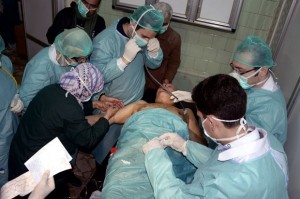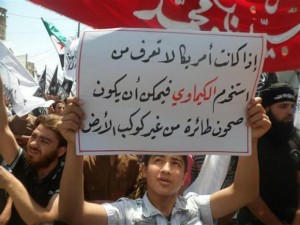 France said Tuesday it has confirmed that the nerve gas sarin was used “multiple times and in a localized way” in Syria, including at least once by the regime. It was the most specific claim by any Western power about chemical weapons attacks in the 27-month-old conflict.
France said Tuesday it has confirmed that the nerve gas sarin was used “multiple times and in a localized way” in Syria, including at least once by the regime. It was the most specific claim by any Western power about chemical weapons attacks in the 27-month-old conflict.
Britain later said that tests it conducted on samples taken from Syria also were positive for sarin.
The back-to-back announcements left many questions unanswered, highlighting the difficulties of confirming from a distance whether combatants in Syria have crossed the “red line” set by President Barack Obama. The regime of Syrian President Bashar Assad has refused to allow U.N. investigators into the country.
The French and British findings, based on samples taken from Syria, came hours after a U.N. team said it had “reasonable grounds” to suspect small-scale use of toxic chemicals in at least four attacks in March and April.
The U.N. probe was conducted from outside Syria’s borders, based on interviews with doctors and witnesses of purported attacks and a review of amateur videos from Syria. The team said solid evidence will remain elusive until inspectors can collect samples from victims directly or from the sites of alleged attacks.
Some experts cautioned that the type of evidence currently available to investigators _ videos, witness reports and physiological samples of uncertain origin _ leaves wide doubts.
At the same time, forensic evidence of alleged chemical weapons use is fading away with time, and the longer U.N. inspectors are kept out of Syria, the harder it will be to collect conclusive proof, they said.
Syria is suspected of having one of the world’s largest chemical weapons arsenals, including mustard and nerve gas, such as sarin. In recent weeks, the regime and those trying to topple Assad have increasingly used accusations of chemical weapons as a propaganda tool, but have offered no solid proof.
In the West, meanwhile, the lack of certainty about such allegations is linked to a high stakes political debate over whether the U.S. should get more involved in the Syria conflict, including by arming those fighting Assad.

Obama has been reluctant to send weapons to the Syrian rebels, in part because of the presence of Islamic militants among them. Obama has warned that the use of chemical weapons or their transfer to a terrorist group would cross a “red line,” hinting at forceful intervention in such an event.
Yet he has insisted on a high level of proof, including a “chain of custody,” that can only come from on-site investigations currently being blocked by the regime.
In Tuesday’s announcement about sarin, French Foreign Minister Laurent Fabius said his government had analyzed several samples, including some brought back from Syria by reporters from the Le Monde newspaper.
He said that there was “no doubt” that at least in one case, the regime and its allies were responsible for the attack. “We have integrally traced the chain, from the attack, to the moment people were killed, to when the samples were taken and analyzed,” Fabius told the TV station France 2.
He said a line was crossed and that “all options are on the table,” including intervening “militarily where the gas is produced or stored.”
In London, Britain’s Foreign Office said samples from Syria were tested at a government laboratory and the presence of sarin was confirmed. It did not say when or where the samples were obtained.
Britain has evidence suggesting a number of different chemical agents have been used, “sometimes including sarin, sometimes not,” said Britain’s ambassador to the United Nations, Mark Lyall Grant.
White House spokesman Jay Carney, speaking before the British announcement, said the French report is “entirely consistent” with the Obama administration’s own findings, but added more work needs to be done to establish who is responsible for the use of the toxic substances and when they were used.
“We need more information,” he said.
Russia, meanwhile, has rejected intelligence the U.S. provided last month suggesting the Assad regime used chemical weapons on its own people, American officials said. A U.S. diplomatic delegation that was sent to Moscow failed to persuade Russian officials and prompted no change in the Kremlin’s support for Assad, said the officials, who spoke on condition of anonymity because they weren’t authorized to speak publicly on the matter.
Experts disagreed on whether the latest chemical weapons allegations mean Obama’s red line has been crossed.
“The verdict is still open,” said Jean Pascal Zanders, an independent chemical weapons consultant, speaking before the French and British announcements.
Zanders said that while claims of chemical weapons use cannot be ignored, the details of the alleged attacks often don’t correspond to the purported symptoms shown in videos or reported by witnesses.
Analyst Michael Eisenstadt said he believes Obama’s red line “has indeed been crossed on a number of times, as there are persistent reports of limited, continued use of chemical weapons from various sources that seem fairly credible.”
The French findings give additional weight to previous suspicions, though “people will want to know about the chain of custody for the evidence,” said Eisenstadt, of the Washington Institute for Near East Policy think tank.
Since allegations of the use of chemical weapons first emerged late last year, the U.N. has investigated on two separate tracks, while France, Britain, Turkey and the U.S. have conducted additional probes.
The team appointed by the Human Rights Council has issued periodic updates about suspected war crimes in Syria, and Tuesday’s report dealt with chemical weapons, among a wide range of topics.
Separately, U.N. chief Ban Ki-moon appointed a U.N. team headed by Swedish chemical weapons experts Ake Sellstrom after the Syrian government asked for an investigation of a purported rebel attack on March 19 on the village of Khan al-Assal, near the northern city of Aleppo.
Syrian soldiers were reportedly killed, and the regime insisted that the U.N. probe be limited to that incident.
Ban wants a broader investigation, including a December incident in the central city of Homs in which opposition activists claimed six rebels died after inhaling white smoke pouring from shells fired in the area. Britain and France have also pushed to widen Sellstrom’s mandate, sending Ban information on additional alleged incidents.
Such allegations are typically based on three types of information that can be obtained without having investigators go into Syria _ amateur videos, witness accounts and physiological samples.
Witnesses and doctors have been interviewed by Skype or after fleeing Syria, while Turkey, Britain and France have analyzed samples that were either smuggled out of the country or taken from suspected victims after they were hospitalized outside Syria.
The Obama administration also referred to such samples when it said in an April letter to two U.S. senators that the U.S. intelligence community had determined, with “varying degrees of confidence,” that the regime has used chemical weapons on a small scale, specifically the nerve gas sarin.
However, the administration cautioned that intelligence assessments are not sufficient, citing the stakes involved.
Claims of chemical weapons attacks also pose a dilemma for journalists.
Some of the videos posted by activists have shown rows of people lying in what appear to be makeshift hospitals, breathing with the aid of oxygen masks, sometimes twitching as they struggle to breathe.
Such videos are often consistent with AP reporting of attacks in that area, but claims that chemical weapons were involved are impossible to verify. The regime continues to bar most independent reporting from areas of fighting.
For example, activists alleged that on May 24, troops fired two rockets with poisonous gas at the rebel-held town of Adra near the capital Damascus, killing three people and wounding more than 40.
Amateur video from a makeshift clinic in the nearby town of Douma where victims were being treated showed young men lying on the floor, some of them twitching as medics poured water on their bodies.
The AP did not report the incident at the time because of the difficulty of confirming the claims. A local reporter who visited the area several days later to interview a doctor and a rebel commander found the evidence was not clear-cut.
A doctor at the Douma clinic who identified himself only by his first name, Seif, for fear of regime retribution, said 60 victims arrived that day and six of them died.
“It was the scariest thing I saw, people came in with strange symptoms like blurred vision, dilated pupils, teary eyes,” he told The Associated Press. “Some had running saliva or were foaming at the mouth.”
Abu Khaled al-Ijweh, a commander of the Lions of Ghouta Brigade, a rebel unit, said he witnessed the attack. He said regime forces fired two suspicious projectiles and fighters started to throw up, with some struggling to walk and dropping to the ground. Al-Ijweh said he managed the symptoms by wearing a mask, drinking vinegar and a liter of water.
In some cases, there is no way to reconcile the opposing narratives.
On April 19, activists said the government bombed the northern town of Saraqeb with chemical agents that caused respiratory problems and other symptoms in people who were exposed to them. The state news agency claimed “terrorists” brought bags of an unknown white powder to Saraqeb and opened them. It said the terrorists _ the regime’s term for the rebels _ then transported the injured to Turkish hospitals to “accuse the Syrian armed troops of using chemical weapons.”
Zanders, the chemical weapons expert, counseled extreme caution.
He noted claims often don’t match the symptoms. Other options, while also conjecture, should at least be considered, such as shells inadvertently hitting shops or homes where chemicals are stored, or the regime using tear gas to instill fear at a time of heightened awareness about the dangers of chemical weapons.
“It becomes a self-reinforcing echo chamber,” he said.
About Sarin
Sarin, or GB, is an organophosphorus compound with the formula [(CH3)2CHO]CH3P(O)F. It is a colorless, odorless liquid, used as a chemical weapon owing to its extreme potency as a nerve agent. It has been classified as a weapon of mass destruction in UN Resolution 687. Production and stockpiling of sarin was outlawed by the Chemical Weapons Convention of 1993 where it is classified as a Schedule 1 substance.
Sarin is estimated to be over 500 times more toxic than cyanide.
Initial symptoms following exposure to sarin are a runny nose, tightness in the chest and constriction of the pupils. Soon after, the victim has difficulty breathing and experiences nausea and drooling. As the victim continues to lose control of bodily functions, the victim vomits, defecates and urinates. This phase is followed by twitching and jerking. Ultimately, the victim becomes comatose and suffocates in a series of tolulope spasms.
Associated press/ Agencies
Top Photo: A Syrian victim who suffered an alleged chemical attack at Khan al-Assal village receives treatment by doctors, at a hospital in Aleppo, Syria.
Leave a Reply
You must be logged in to post a comment.